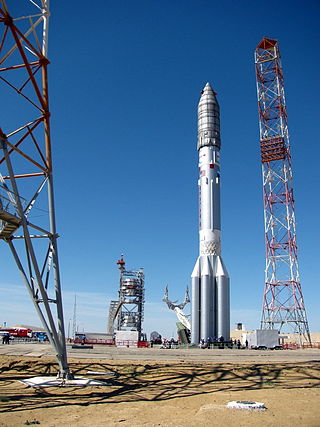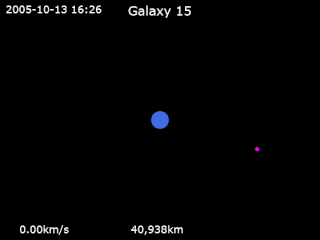
Intelsat S.A. is a multinational satellite services provider with corporate headquarters in Luxembourg and administrative headquarters in Tysons Corner, Virginia, United States. Originally formed as International Telecommunications Satellite Organization, from 1964 to 2001, it was an intergovernmental consortium owning and managing a constellation of communications satellites providing international telecommunications and broadcast services.
SES Americom was a major commercial satellite operator of North American geosynchronous satellites based in the United States. The company started as RCA Americom in 1975 before being bought by General Electric in 1986 and then later acquired by SES in 2001. In September 2009, SES Americom and SES New Skies merged into SES World Skies.
AMC-3 is a commercial broadcast communications satellite owned by SES. Launched on 4 September 1997, from Cape Canaveral, Florida, AMC-3 is a hybrid C-band / Ku-band satellite. It provides coverage to Canada, United States, Mexico, Caribbean. Located in a geostationary orbit parallel to the Yucatán Peninsula and Great Lakes, AMC-3 provides service to commercial and government customers, with programming distribution, satellite news gathering and broadcast internet capabilities.
AsiaSat 5 is a Hong Kong communications satellite, which is operated by the Hong Kong based Asia Satellite Telecommunications Company (AsiaSat). It is positioned in geostationary orbit at a longitude of 100.5° East of the Greenwich Meridian, where it replaced the AsiaSat 2 satellite. It is used to provide fixed satellite services, including broadcasting, telephone and broadband very small aperture terminal (VSAT) communications, to Asia and the Pacific Ocean region.
AMC-11 , previously GE-11, is an American geostationary communications satellite which is operated by SES It is currently positioned in geostationary orbit at a longitude of 131° West, from where it is used to relay cable television across North America for onward distribution. It broadcasts to Canada, the Caribbean, Mexico and the United States.
AMC-6, formerly GE-6, is a commercial broadcast communications satellite owned by SES Launched on 21 October 2000, from Baikonur Cosmodrome in Kazakhstan, AMC-6 became the fifth hybrid C-band / Ku-band satellite in the GE Americom fleet. The satellite provides coverage to the continental United States, Canada, the Caribbean islands, southern Greenland, and Latin America. Located in a geostationary orbit parallel to the eastern United States coastline, AMC-6 provides service to commercial and government customers, and is used as an Internet platform due to its wide coverage, scale and redundancy. Some of its capabilities include Very-small-aperture terminal (VSAT) networking, satellite news gathering and Ku-band transceiver service. Launched as GE-6, it was renamed AMC-6 when SES took over GE Americom in 2001, forming SES Americom. This merged with SES New Skies in 2009 to form SES World Skies.
AMC-4 is a commercial broadcast communications satellite owned by SES World Skies, part of SES. Launched in 1999, from Centre Spatial Guyanais, ELA-2 by Ariane 44LP H10-3. It provides coverage to North America, Latin America, Caribbean. Located in a geostationary orbit, AMC-4 provides service to commercial and government customers, with programming distribution, satellite news gathering and broadcast internet capabilities.

The Proton-M, (Протон-М) GRAU index 8K82M or 8K82KM, is an expendable Russian heavy-lift launch vehicle derived from the Soviet-developed Proton. It is built by Khrunichev, and launched from sites 81 and 200 at the Baikonur Cosmodrome in Kazakhstan. Commercial launches are marketed by International Launch Services (ILS), and generally use Site 200/39. The first Proton-M launch occurred on 7 April 2001.
AMC-14 is a communications satellite. Initially owned by SES Americom, AMC-14 was designed to be placed in geostationary orbit, following launch on a Proton-M / Briz-M space vehicle. Built by Lockheed Martin and based on the A2100 satellite bus, AMC-14 was to have been located at 61.5° West longitude for Dish Network service.
ProtoStar Ltd was a private company incorporated in Bermuda, with U.S. operations based in San Francisco, California and Asian operations based in Singapore. ProtoStar intended to operate an initial fleet of three geostationary satellites. Two satellites were acquired and launched. ProtoStar's anchor customer, Dish TV India Limited, is the largest direct-to-home television operator in India.
AMC-21, or GE-21, is an American communications satellite operated by SES S.A., formerly SES World Skies and SES Americom. It was launched in August 2008 and is expected to remain in service for approximately 15 years. It is currently located at 125° West longitude.
Astra 1M is a geostationary communications satellite which is operated by SES. It is positioned in geostationary orbit at a longitude of 19.2° East, from where it is used to provide direct to home (DTH) broadcasting to Europe, Africa, and the Middle East.

Galaxy 15 is an American telecommunications satellite which is owned by Intelsat. It was launched for and originally operated by PanAmSat, and was subsequently transferred to Intelsat when the two companies merged in 2006. It was originally positioned in geostationary orbit at a longitude of 133° West, from where it was used to provide communication services to North America.
SES-3 is a communications satellite operated by SES World Skies, then by SES S.A.
AMC-15 is an American communications satellite. Owned by SES Americom, AMC-15 was designed to be placed in geostationary orbit, following launch on a Proton-M / Briz-M space vehicle.
AMC-9 is a commercial broadcast communications satellite owned by SES World Skies, part of SES S.A. Launched on 6 June 2003, from Baikonur Cosmodrome, Kazakhstan, on the 300th launch of a Proton family rocket, AMC-9 is a hybrid C-band / Ku-band satellite located at 83° West, covering Canada, United States, Mexico, and Caribbean. It is owned and operated by SES S.A., formerly SES Americom.
JCSAT-4 was known as JCSAT-R until it was sold to INTELSAT in 2009. It is a geostationary communications satellite designed and manufactured by Hughes on the HS-601 satellite bus. It was originally ordered by JSAT Corporation, which later merged into the SKY Perfect JSAT Group. It has a mixed Ku-band and C-band payload and was used as an on orbit spare.
NSS-5 is a communications satellite operated by Intelsat and after by SES World Skies. Launched in 1997 it was operated in geostationary orbit at a longitude of 50.5 degrees east for around 14 years.


